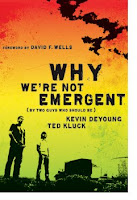 With regards to the church of God on this planet we are in an era, like many others beforehand, where the up-and-coming generations of leaders are wrestling with age-old questions of “What is church?” It is not a self-serving question – in the end it bottles down to, “What’s the point?” – which brings us to Jesus, and that is good.
With regards to the church of God on this planet we are in an era, like many others beforehand, where the up-and-coming generations of leaders are wrestling with age-old questions of “What is church?” It is not a self-serving question – in the end it bottles down to, “What’s the point?” – which brings us to Jesus, and that is good.
This wrestle is often marked by debate about the essential nature of the church, how spirituality is to be expressed, and what mission is to be achieved by whom in what way. As a supposedly mildly-postmodern Gen-Xer I have been caught up in this debate. I have felt and articulated angst against the mainstream, I have been left confused and nauseatingly abandoned by the vacuous left and the experientially pentecostal and hammered by the hardcore conservative rightwing. New Calvinism excites me but I am wary, Rob Bell annoys me but I like to be generous.
You can see from the title of this book, DeYoung and Kluck’s Why We’re Not Emergent subtitled with “by two guys who should be”, how it is a part of this ongoing churn. It’s a valuable part.
The book is a critique of the “emergent church” movement – a movement which resists the term, is wrapped around the personalities and writings of the likes of Rob Bell (of nooma fame) and Brian McLaren, and is characterised by a postmodern spirituality of journey, narrative and discovery. And like it’s subject, the critique is messy and somewhat nebulous. Kevin DeYoung brings a theological mind, handling concepts and issues academically, pastorally. Ted Kluck shares anecdotes and reflections like an opinion page in a newspaper (he’s a journalist). It sort of works. Enough.
They are certainly not playing with straw men. They understand the emergent church culture, the personalities, the catchcries (“EPIC: experiential, participatory, image driven, and connected” (page 18) is one I have used myself), and the inconsistencies. The rhetorical section entitled “Are You Emergent?” was immensely enjoyable:
“After reading nearly five thousand pages of emerging-church literature, I have no doubt that the emerging church, while loosely defined and far from uniform, can be described and critiqued as a diverse but recognizable, movement. You might be an emergent Christian: if you listen to U2, Moby, and Johnny Cash’s Hurt (sometimes in church), use sermon illustrations from The Sopranos, drink lattes in the afternoon and Guinness in the evenings, and always use a Mac… [a page later]… if you’ve ever been to a church with prayer labyrinths, candles, Play-Doh, chalk-drawings, couches or beanbags (your youth group doesn’t count); if you loathe words like linear, propositional, rational, machine, and hierarchy and use words like ancient-future, jazz, mosaic, matrix, missional, vintrage, and dance;… [etc.]” (page 20ff)
Despite the necessary lack of precision they handle the critique well, bottling it down to some useful key issues. DeYoung’s theological training is obvious and I found his chapters more useful. A precis would not be valuable, but two key concepts they tackle are worth a mention.
The first is the concept of whether or not we can grasp God. In the face of a movement in which “It’s really cool to search for God. It’s not very cool to find him.” (page 32) they wish to assert that God, in revealing himself, has made himself knowable (page 35ff). The doctrine of revelation and epistemological angst is at the heart of engagement with postmodernity. They do it well.
Of even greater value, however, is their engagement towards the end of the book with the uniqueness of Christ. Here they tackle the well-worn yet bleedingly-arrogant accusations of the liberal left that would relegate atonement to “cosmic child abuse” (page 194) and cry for self-actualised social justice while scorning any concept that God might actually love humanity so much that injustice suffers his wrath.
“The emergent emphasis of justice and compassion would be more of a helpful corrective if it went hand in hand with a firm, unashamed belief, made central and upfront, in the reality of everlasting punishment and everlasting reward, the resurrection of all men either to life or judgement, and the necessity of faith in Jesus Christ.” (page 187)
Their demonstration of the ultimate gracelessness of the social gospel is helpful and the strongest critique in the book. Their related consideration of overrealised eschatology (page 184ff) highlights the danger of overstepping “incarnational” or “contextualised” mission and moving to the place where we make the church itself, or some social cause, or some self-actualising journey inherently messianic in which Jesus is nothing but a visual aide.
And so it’s a good pushback into this generational, ecclesiastical wrestle. It’s good that it’s written by a couple of young guns which means it never comes near to reading like some pietistic elder-guru intoning dogma.
It has some flaws. I think they should stick with “emerging” or “emergent” rather than interchange these labels which are becoming more concretely used to demarcate between those that want to share a journey (emergent) and those that want to share a gospel (emerging).
And I am surprised that there is only one mention of Mark Driscoll (page 165). That’s a nice surprise for me actually as it shows that you can talk about this stuff without talking about Mars Hill Seattle. But it’s interesting that for a very recent book (2008) they haven’t considered reflecting on things in the light of New Calvinism and the Driscoll brand of emerging (not emergent) church.
In the end, and from the broad vibe of the book, my greatest appreciation comes from a resonance with my own feelings of the moment. I’m really quite sick of all the “missional” gumph. I’m tired of jumping through cultural hoops that never seem to work and are usually just shots in the dark by a few know-it-alls. I’m not smart enough to figure out which way the Holy Spirit is blowing and my heart is not big enough to contain the burden of those around me who need Jesus so much. Right now I just want to keep it simple, preach the gospel, defend the poor, and rest in God. I see that here:
“…my hope is that we could be marked by grace and truth, logical precision and warmhearted passion, careful thinking and compassionate feeling, strong theology and tender love, Christian liberty and spiritual discipline, congregational care and committed outreach, diversity without doctrinal infidelity, ambition without arrogance, and contentment without complacency.” (page 251)
Pastor DeYoung, Amen.


 Anonymous asks:
Anonymous asks:







